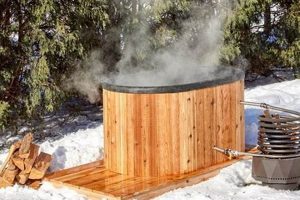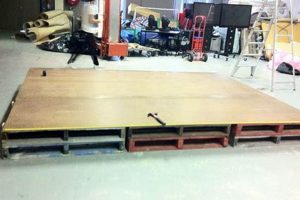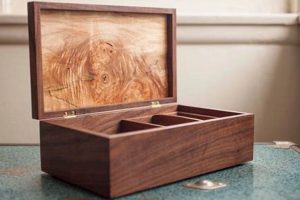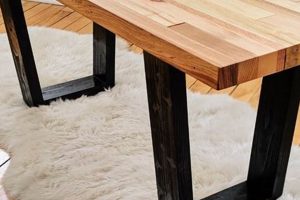A self-assembled partition constructed primarily from timber materials, designed to delineate space within a room, presents an alternative to permanent wall construction. These structures can range from simple, single-panel screens to more elaborate, multi-panel units, often incorporating decorative elements or storage features.
The utilization of such dividers allows for adaptable spatial configuration, enabling the temporary or semi-permanent modification of room layouts to suit evolving needs. Benefits include cost-effectiveness compared to professional renovation, ease of assembly and disassembly, and the potential for personalization through varied designs and finishes. Historically, similar space-dividing screens have been employed across cultures, serving both functional and aesthetic purposes, providing privacy, and enhancing interior design.
The following sections will delve into various aspects related to building these partitions, covering material selection, design considerations, construction techniques, and finishing options to assist in creating functional and visually appealing interior partitions.
Construction Guidance
Effective construction relies on careful planning and execution. The following guidelines provide insights for building a durable and aesthetically pleasing partition.
Tip 1: Precise Measurement and Planning: Accurate dimensions are crucial for a successful project. Prior to cutting any lumber, meticulously measure the intended space and create a detailed plan outlining all dimensions and material requirements. This minimizes waste and potential errors.
Tip 2: Material Selection: Choosing appropriate lumber impacts the divider’s stability and appearance. Consider hardwoods like oak or maple for durability, or softwoods like pine for cost-effectiveness. Ensure the wood is properly seasoned to prevent warping or cracking after assembly.
Tip 3: Frame Construction: A robust frame is the foundation of a stable partition. Utilize strong joinery techniques such as mortise and tenon or pocket screws to ensure the frame’s structural integrity. Reinforce corners with metal brackets for added stability.
Tip 4: Panel Integration: Consider various panel options like fabric, wood slats, or decorative screens. Securely attach panels to the frame, ensuring they are flush and evenly spaced. Utilize appropriate fasteners, such as staples or screws, based on the panel material.
Tip 5: Surface Finishing: Applying a protective finish enhances the partition’s appearance and longevity. Sand all surfaces smooth before applying stain, paint, or varnish. Multiple coats may be necessary to achieve the desired finish and protection.
Tip 6: Hardware Selection: Choose hinges, casters, or feet that complement the design and functionality. Ensure hinges are appropriately sized and positioned for smooth operation. Select casters with locking mechanisms for stability when the partition is in use.
Successful construction requires meticulous attention to detail and adherence to established woodworking principles. By implementing these strategies, a functional and visually appealing partition can be achieved.
The subsequent section will address considerations for alternative designs and customized features.
1. Design
Design constitutes the foundational blueprint for any self-assembled timber partition, directly influencing its functionality, aesthetic integration within a space, and overall structural integrity. The design phase dictates dimensions, panel configuration, joinery methods, and aesthetic elements, all of which are critical determinants of the divider’s success. A poorly considered design can lead to instability, visual disharmony, or functional limitations. For example, a minimalist design might prioritize clean lines and lightweight materials, requiring precise measurements and joinery to maintain stability. Conversely, an ornate design incorporating intricate carvings or heavy panels necessitates a robust frame and appropriate weight distribution to prevent collapse or warping.
Furthermore, the design process must account for the intended use and environmental context of the partition. A divider intended for a high-traffic area requires a durable and stable construction, potentially incorporating features such as reinforced corners or locking casters. A divider designed for a small space might prioritize maximizing light penetration through the use of translucent panels or open slat designs. The aesthetic aspects of the design, including the selection of wood species, finishes, and decorative elements, contribute significantly to the divider’s visual integration with the surrounding decor, thus ensuring harmony and enhancing the overall ambience of the space. A design plan should also consider accessibility for maintenance and potential future modifications.
In summary, the design phase represents a critical stage in the construction of a timber partition. It necessitates a thorough understanding of structural principles, material properties, and aesthetic considerations. A well-executed design not only ensures the functionality and stability of the divider but also enhances its visual appeal and seamless integration within the intended environment. Neglecting the design phase will result in a substandard outcome with potential instability, aesthetic disharmony, and functional limitations. Therefore, the design should serve as the central element of the planning phase.
2. Materials
Material selection constitutes a critical phase in the self-assembly of timber partitions, directly impacting structural integrity, longevity, aesthetic qualities, and overall cost-effectiveness. The choice of materials extends beyond the primary wood components to include fasteners, finishes, and any supplementary elements incorporated into the design.
- Wood Species
The selection of wood species influences the divider’s durability, weight, and aesthetic characteristics. Hardwoods, such as oak, maple, or cherry, offer superior strength and resistance to wear, making them suitable for high-traffic areas or designs requiring robust structural support. Softwoods, including pine, fir, or cedar, provide a more economical alternative, suitable for lighter-duty partitions or those where cost is a primary concern. The natural grain and color variations inherent in different wood species also contribute to the overall aesthetic appeal.
- Fasteners
The type and quality of fasteners employed in construction dictate the stability and longevity of the assembled structure. Screws, nails, and bolts serve to join wood components, with screws generally providing a more secure and durable connection than nails. The selection of fastener material, such as steel, brass, or stainless steel, should consider the potential for corrosion or staining. The appropriate size and spacing of fasteners are also crucial for ensuring adequate load distribution and preventing structural failure.
- Finishes
Surface finishes protect the timber from moisture, UV radiation, and physical damage, while also enhancing its aesthetic appearance. Stains penetrate the wood, accentuating its natural grain patterns and altering its color. Paints provide an opaque coating, offering a wider range of color options and greater protection against the elements. Varnishes and sealants create a protective layer on the wood’s surface, providing resistance to scratches and water damage. The selection of finish should align with the intended use and environmental conditions, as well as the desired aesthetic outcome.
- Panel Inserts
Many designs incorporate panel inserts composed of various materials that impact not only the look but also the functionality of the overall diy wood room divider. Options range from fabric and paper to frosted or clear glass and even metal. These material options change the weight, visibility, durability, maintenance and cost and may all impact the design and material choices of the wooden frame.
The careful consideration and selection of materials are paramount to the successful construction of a durable, aesthetically pleasing, and functional partition. Neglecting this aspect will invariably lead to compromised structural integrity, diminished aesthetic appeal, and reduced lifespan. Therefore, thorough research and informed decision-making regarding material selection represent a critical investment in the long-term viability of the project.
3. Measurements
Precise measurements are fundamental to the successful construction of any self-assembled timber partition. Inaccurate dimensions can lead to structural instability, aesthetic disharmony, and functional limitations. A direct causal relationship exists between the accuracy of measurements taken during the planning phase and the final quality of the finished divider. For instance, if the measured height of a room is underestimated, the resulting divider may not fully extend to the ceiling, creating an undesirable gap. Similarly, imprecise width measurements can result in panels that do not fit within the frame, necessitating costly rework or rendering the entire project unusable.
The importance of accurate measurements extends beyond the overall dimensions of the divider. Precise measurements are critical for cutting individual components, such as frame members and panel inserts. Inconsistent lengths or angles in frame members can compromise the structural integrity of the divider, leading to warping or instability. Similarly, inaccurate measurements for panel inserts can result in gaps, misalignment, or difficulty in securing the panels within the frame. The utilization of precision tools, such as laser levels and digital measuring devices, can mitigate the risk of human error and ensure a higher degree of accuracy. For example, when constructing a multi-panel folding screen, even a small error in the angle of a hinge placement, multiplied across several panels, can result in the screen not folding correctly or sitting flush when open.
In summary, accurate measurement is an indispensable component of self-assembled timber partition construction. The adoption of meticulous measurement techniques and the utilization of appropriate tools are essential for mitigating the risk of errors and ensuring the creation of a structurally sound, aesthetically pleasing, and functionally effective room divider. Failure to prioritize accurate measurement will inevitably result in compromised quality and increased project costs. Attention to accurate and precise measurements must be placed as the starting point for this project.
4. Construction
Construction, in the context of timber partitions, embodies the practical execution of a pre-defined design, transforming raw materials into a functional and aesthetically coherent structure. It is the process by which the intended functionality of a partition is realized, and its integration into the existing spatial environment achieved. Erroneous construction techniques directly compromise the intended benefits of spatial division, acoustic buffering, or aesthetic enhancement. For example, inadequate joinery can lead to instability in a free-standing screen, undermining its ability to effectively delineate space. Similarly, misaligned paneling disrupts visual harmony, negating the aesthetic objectives of the design.
The selection and application of appropriate construction methods dictate the long-term performance and durability of the divider. The implementation of reinforced joinery techniques, such as mortise-and-tenon or dovetail joints, contributes to a more robust and resilient structure compared to simpler methods like butt joints secured with nails. Precise alignment and secure fastening of panels are also crucial. Consider the scenario of a fabric-covered divider: insufficient tensioning of the fabric during installation results in sagging or wrinkling, detracting from both its aesthetic appeal and acoustic properties. Proper construction also involves the safe and efficient handling of materials, minimizing waste and ensuring the structural integrity of each component. When working with power tools, a thorough understanding of proper usage is critical, as is personal safety equipment. Incorrect techniques may cause unsafe structures and wasted resources.
In summary, construction represents a transformative process wherein a design concept is manifested into a tangible and functional timber partition. The selection and meticulous execution of appropriate construction techniques dictate the structural integrity, longevity, aesthetic qualities, and overall effectiveness of the finished product. Poorly executed construction undermines the value proposition of the divider, compromising its functionality and aesthetic appeal. Therefore, a comprehensive understanding of construction principles and meticulous attention to detail during the assembly process are paramount to the success of any timber partition project, reinforcing the importance of construction as a critical component in achieving the desired outcome.
5. Finishing
Finishing, in the context of self-assembled timber partitions, is the application of surface treatments designed to protect the wood, enhance its aesthetic qualities, and contribute to the divider’s overall longevity. The connection between finishing and the final product is causal: the quality and type of finish directly influence the wood’s resistance to moisture, ultraviolet (UV) radiation, physical abrasion, and biological degradation. Untreated or improperly finished timber is susceptible to warping, cracking, fading, and insect infestation, significantly reducing the lifespan and visual appeal of the divider. For example, a partition constructed from pine and left unfinished will rapidly deteriorate in a humid environment, whereas the same partition treated with a marine-grade varnish will exhibit superior resistance to moisture damage.
The selection of an appropriate finish is contingent upon the intended use of the room divider, the species of wood employed, and the desired aesthetic effect. Options range from penetrating oils and stains to film-forming varnishes, lacquers, and paints. Penetrating oils, such as linseed oil or tung oil, enhance the natural grain of the wood and provide a subtle sheen, but offer limited protection against abrasion and moisture. Varnishes and lacquers create a durable, protective layer on the wood’s surface, providing resistance to scratches, stains, and UV radiation. Paints offer a wide range of color options and can be formulated to provide specialized properties, such as mold resistance or low volatile organic compound (VOC) emissions. The correct application method and number of coats are also critical factors. Insufficient preparation or uneven application can result in a blotchy or uneven finish, while inadequate curing time can compromise the protective properties of the coating.
In summary, the finishing stage represents a crucial element in the construction of a durable and aesthetically pleasing timber partition. The choice of finish, the application technique, and the adherence to recommended curing times directly influence the long-term performance and visual appeal of the divider. Neglecting this phase or employing substandard finishing practices can compromise the structural integrity and aesthetic value of the entire project. Therefore, the selection and application of an appropriate finish should be considered an integral part of the construction process, contributing significantly to the overall success and longevity of the finished product.
6. Stability
Stability represents a paramount consideration in the design and construction of any self-assembled timber partition. The inherent function of a room divider necessitates structural integrity to prevent collapse or toppling, ensuring safety and long-term usability. Compromised stability directly undermines the intended purpose of spatial division and poses potential hazards.
- Base Support and Weight Distribution
The design of the base significantly influences overall stability. A wide base provides a lower center of gravity, enhancing resistance to tipping. Uneven weight distribution can create instability; heavier panels should be positioned lower or balanced with counterweights. Examples include utilizing wider feet or a supporting brace at the base of a tall, narrow divider, or incorporating heavier materials in the lower sections to offset lighter panels above. Improper weight distribution leads to a higher risk of accidental displacement.
- Joinery Techniques
The strength and type of joinery employed directly affects the rigidity and stability of the structure. Robust joints, such as mortise-and-tenon or dowel joints, create stronger connections compared to simpler butt joints secured with nails. Insufficiently strong joints allow for racking or movement, compromising the structural integrity of the divider. Consider a multi-panel folding screen; weak hinge joints result in a wobbly structure prone to collapse.
- Material Selection and Rigidity
The inherent rigidity of the chosen timber species and panel materials significantly influences the overall stability. Denser hardwoods generally provide greater structural stability compared to softer woods. Using thin or flexible panel materials can reduce stability, particularly in larger dividers. For instance, a large divider constructed with lightweight panels requires a more robust frame to prevent swaying or buckling.
- Environmental Factors and Anchoring
External environmental conditions, such as wind or uneven flooring, can impact stability. Dividers positioned in areas prone to drafts or impacts require additional stabilization. Anchoring the divider to the floor or wall provides a secure connection, preventing accidental tipping. Examples include using floor anchors in high-traffic areas or implementing adjustable feet to compensate for uneven surfaces.
These considerations collectively ensure the stability of a timber partition. Adequate base support, robust joinery, appropriate material selection, and accounting for environmental factors all contribute to a structure capable of fulfilling its intended function safely and reliably. A failure to address these elements compromises the divider’s utility and poses a safety risk, highlighting the critical interplay between design, material choices, construction, and environmental context in achieving a stable and functional room divider.
7. Hardware
Hardware components are integral to the functionality, durability, and aesthetic integration of a self-assembled timber partition. The selection and implementation of appropriate hardware elements directly influence the ease of assembly, the structural integrity, and the operational characteristics of the finished product. Substandard hardware can compromise the stability of the divider, hinder its intended function, and detract from its overall aesthetic appeal. For example, hinges of insufficient load capacity on a folding screen can lead to sagging or breakage, impeding smooth operation and potentially causing structural failure. Similarly, improperly sized or positioned fasteners can weaken joints, reducing the overall stability and longevity of the partition. Casters chosen without consideration for floor surface or load-bearing capacity can result in difficult maneuverability or even damage to the flooring surface. Therefore, a considered selection process is paramount to ensuring that hardware meets the specific requirements of the design.
The practical application of appropriate hardware extends beyond mere functionality to encompass aesthetic considerations. Hardware finishes and styles should complement the overall design aesthetic of the partition. Exposed hinges, latches, or handles provide opportunities for decorative embellishment, contributing to the overall visual appeal of the finished piece. Conversely, mismatched or poorly chosen hardware can detract from the aesthetic coherence of the partition. Furthermore, the placement and installation of hardware must be precise to ensure optimal performance. Misaligned hinges or improperly secured latches can impede smooth operation or compromise the structural integrity of the divider. Consider, for instance, a sliding panel partition: accurately installed tracks and rollers are essential for ensuring effortless and reliable movement. Similarly, magnetic catches used to secure folding panels must be precisely aligned to ensure proper closure.
In summary, hardware constitutes a critical, often understated, element in the creation of a self-assembled timber partition. The correct selection, careful installation, and aesthetic integration of hardware components are fundamental to achieving a functional, durable, and visually appealing finished product. Challenges arise in balancing cost considerations with performance requirements, necessitating a thorough understanding of available options and their respective strengths and weaknesses. The proper application of appropriate hardware elements ensures that the finished divider effectively fulfills its intended purpose while contributing to the overall aesthetic harmony of the space in which it is situated. The cost of quality hardware needs to be taken into account from the initial design phase.
DIY Wood Room Divider
The following section addresses common inquiries regarding the construction of timber partitions, providing concise and informative responses to frequently raised questions.
Question 1: What wood species are most suitable for constructing a durable and aesthetically pleasing divider?
Hardwoods such as oak, maple, and cherry offer superior durability and visual appeal, but necessitate greater expense and specialized tools. Softwoods like pine and fir provide a more economical alternative, suitable for projects where cost is a primary concern; however, they demand increased attention to finishing and structural reinforcement.
Question 2: What joinery techniques offer the greatest stability for a timber partition frame?
Mortise-and-tenon joints, dovetail joints, and dado joints provide superior structural integrity compared to simpler butt joints. Pocket-hole screws can also offer a strong and concealed joint. The selection of the appropriate joinery technique should correlate with the scale, weight, and intended use of the partition.
Question 3: How can warping or twisting of lumber be prevented during the construction process?
Employing kiln-dried lumber is essential to minimize moisture content and subsequent dimensional changes. Storing lumber in a dry, stable environment prior to construction also contributes to preventing warping. Applying a sealant or finish to all surfaces of the timber helps to regulate moisture absorption and minimize dimensional changes. A good design can also help by utilizing multiple smaller pieces of wood, which are less prone to warping, instead of one large piece.
Question 4: What are the key considerations when integrating panel inserts into a timber partition?
Panel inserts should be securely fastened to the frame using appropriate adhesives, fasteners, or molding. Ensure proper alignment and spacing to maintain a consistent and aesthetically pleasing appearance. The choice of panel material should complement the overall design and functionality of the partition, considering factors such as light transmission, privacy, and acoustic properties.
Question 5: How should a timber partition be finished to ensure long-term protection and visual appeal?
Proper surface preparation, including sanding and cleaning, is essential for optimal finish adhesion. Select a finish appropriate for the intended use and environment, considering factors such as moisture exposure, UV radiation, and abrasion resistance. Apply multiple thin coats of finish, allowing adequate drying time between coats, to achieve a durable and aesthetically pleasing surface. For projects employing multiple types of wood or materials it is important to test the finishes on scraps before applying to the final project.
Question 6: How can stability be maximized in a free-standing timber partition?
Design a wide and stable base to lower the center of gravity. Employ robust joinery techniques to ensure structural integrity. Consider anchoring the partition to the floor or wall for added stability, particularly in high-traffic areas or environments prone to movement. Distribute weight evenly to prevent tipping. Add weights to the base as needed.
Careful planning, material selection, and execution are crucial for creating a durable, functional, and aesthetically pleasing partition. By addressing these common questions, constructors can minimize potential issues and achieve a successful project outcome.
The following section will offer a conclusion summarizing key points discussed in this guide.
Conclusion
This guide has systematically addressed the multifaceted aspects of constructing a self-assembled timber partition, emphasizing the critical interplay between design, materials, measurements, construction techniques, finishing practices, stability considerations, and hardware implementation. The thorough exploration of each component underscores the necessity of meticulous planning and execution to achieve a durable, functional, and aesthetically pleasing outcome. The success of a “diy wood room divider” project hinges upon a comprehensive understanding of these principles.
As spatial demands evolve and personalized environments gain prominence, the relevance of adaptable interior solutions remains enduring. The information presented serves as a foundation for informed decision-making, encouraging responsible material sourcing, sustainable construction practices, and innovative design approaches. The construction of a timber partition represents not only a functional endeavor but also an opportunity to express individual creativity and enhance the quality of interior spaces, contributing to long-term value and aesthetic satisfaction. The commitment to craftsmanship and informed application of these principles yields dividends that extend beyond the immediate project, enriching the built environment with adaptable solutions.



![[DIY Guide] Easy DIY Wood Window Shutters You Can Build! The DIY Hub: Creative Crafts, Repairs & Life Hacks [DIY Guide] Easy DIY Wood Window Shutters You Can Build! | The DIY Hub: Creative Crafts, Repairs & Life Hacks](https://craftingdiycenter.com/wp-content/uploads/2025/07/th-3579-300x200.jpg)



